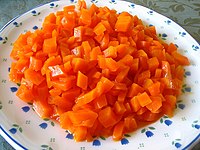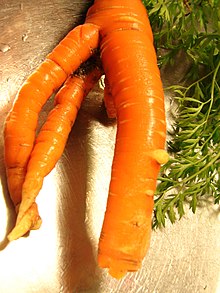| Carrot | |
|---|---|
 | |
| Harvested carrots | |
| Scientific classification | |
| Kingdom: | Plantae |
| (unranked): | Angiosperms |
| (unranked): | Eudicots |
| (unranked): | Asterids |
| Order: | Apiales |
| Family: | Apiaceae |
| Genus: | Daucus |
| Species: | D. carota |
| Binomial name | |
| Daucus carota L. | |
It is a biennial plant which grows a rosette of leaves in the spring and summer, while building up the stout taproot, which stores large amounts of sugars for the plant to flower in the second year. The flowering stem grows to about 1 metre (3 ft) tall, with an umbel of white flowers that produce a fruit called a mericarp by botanists, which is a type of schizocarp.[1]
Contents
|
Uses
| Nutritional value per 100 g (3.5 oz) | |
|---|---|
| Energy | 173 kJ (41 kcal) |
| Carbohydrates | 9 g |
| Sugars | 5 g |
| Dietary fibre | 3 g |
| Fat | 0.2 g |
| Protein | 1 g |
| Vitamin A equiv. | 835 μg (93%) |
| - beta-carotene | 8285 μg (77%) |
| Thiamine (Vit. B1) | 0.04 mg (3%) |
| Riboflavin (Vit. B2) | 0.05 mg (3%) |
| Niacin (Vit. B3) | 1.2 mg (8%) |
| Vitamin B6 | 0.1 mg (8%) |
| Folate (Vit. B9) | 19 μg (5%) |
| Vitamin C | 7 mg (12%) |
| Calcium | 33 mg (3%) |
| Iron | 0.66 mg (5%) |
| Magnesium | 18 mg (5%) |
| Phosphorus | 35 mg (5%) |
| Potassium | 240 mg (5%) |
| Sodium | 2.4 mg (0%) |
| Percentages are relative to US recommendations for adults. | |
In India carrots are used in a variety of ways, as salads or as vegetables added to spicy rice or daal dishes, and the most popular variation in north India is the Gaajar Kaa Halwaa carrot dessert, which has carrots grated and cooked in milk until the whole thing is solid, after which nuts and butter are added. Carrot salads are usually made with grated carrots in western parts with a seasoning of mustard seeds and green chillies popped in hot oil, while adding carrots to rice usually is in julienne shape.
The variety of carrot found in north India is rare everywhere except in Central Asia and other contiguous regions, and is now growing in popularity in larger cosmopolitan cities in South India. The north Indian carrot is pink-red comparable to plum or raspberry or deep red apple in colour (without a touch of yellow or blue) while most other carrot varieties in world are from orange to yellow in colour, comparable to hallowe'en pumpkins.
Ever since the late 1980s, baby carrots or mini-carrots (carrots that have been peeled and cut into uniform cylinders) have been a popular ready-to-eat snack food available in many supermarkets.
Carrot juice is also widely marketed, especially as a health drink, either stand-alone or blended with fruits and other vegetables.
Companion plant
Carrots are useful companion plants for gardeners. There is experimental evidence[citation needed] that growing it intercropped with tomatoes increases tomato production. If left to flower, it (like any umbellifer) attracts predatory wasps which kill many garden pests.Nutrition

Carrot tzimmes
Lack of vitamin A can cause poor vision, including night vision, and vision can be restored by adding it back into the diet. An urban legend says eating large amounts of carrots will allow one to see in the dark. The legend developed from stories of British gunners in World War II, who were able to shoot down German planes in the darkness of night. The legend arose during the Battle of Britain when the RAF circulated a story about their pilots' carrot consumption as an attempt to cover up the discovery and effective use of radar technologies in engaging enemy planes, as well as the use of red light (which does not destroy night vision) in aircraft instruments.[4][5] It reinforced existing German folklore and helped to encourage Britons—looking to improve their night vision during the blackouts—to grow and eat the vegetable.
Ethnomedically, the roots are used to treat digestive problems, intestinal parasites, and tonsillitis or constipation.
History

A basket of carrots displayed in a Singapore supermarket.

Workers harvesting carrots, Imperial Valley, California, 1948
In early use, carrots were grown for their aromatic leaves and seeds, not their roots. Some relatives of the carrot are still grown for these, such as parsley, fennel, dill and cumin. The first mention of the root in classical sources is in the 1st century CE. The modern carrot appears to have been introduced to Europe in the 8-10th centuries.[citation needed] The 12th c. Arab Andalusian agriculturist, Ibn al-'Awwam, describes both red and yellow carrots; Simeon Seth also mentions both colours in the 11th century. Orange-coloured carrots appeared in the Netherlands in the 17th century.[8] These, the modern carrots, were intended by the antiquary John Aubrey (1626–1697) when he noted in his memoranda "Carrots were first sown at Beckington in Somersetshire Some very old Man there [in 1668] did remember their first bringing hither."[9]
In addition to wild carrot, these alternative (mostly historical) names are recorded for Daucus carota: bee's-nest, bee's-nest plant, bird's-nest, bird's-nest plant, bird's-nest root, carota, carotte (French), carrot, common carrot, crow's-nest, daucon, dawke, devil's-plague, fiddle, gallicam, garden carrot, gelbe Rübe (German), gingidium, hill-trot, laceflower, mirrot, Möhre (German), parsnip (misapplied), Queen Anne's lace, rantipole, staphylinos, and zanahoria.[10]
Cultivars
 Carrots can be selectively bred to produce different colours. |
The city of Holtville, California, promotes itself as "Carrot Capital of the World", and holds an annual festival devoted entirely to the carrot.
Eastern carrots
Eastern carrots were domesticated in Central Asia, probably in modern-day Iran and Afghanistan in the 10th century, or possibly earlier. Specimens of the eastern carrot that survive to the present day are commonly purple or yellow, and often have branched roots. The purple colour common in these carrots comes from anthocyanin pigments.Western carrots
The western carrot emerged in the Netherlands in the 17th century ,[11]from Iran with violet colour, its orange colour making it popular in those countries as an emblem of the House of Orange and the struggle for Dutch independence. The orange colour results from abundant carotenes in these cultivars. While orange carrots are the norm in the West, other colours do exist, including white, yellow, red, and purple. These other colours of carrot are raised primarily as novelty crops.The Vegetable Improvement Center at Texas A&M University has developed a purple-skinned, orange-fleshed carrot, the BetaSweet (also known as the Maroon Carrot), with substances to prevent cancer, which has recently entered very limited commercial distribution, through J&D Produce of Edinburg, Texas. This variety of carrot is also known to be high in β-carotene which is an essential nutrient. The high concentrations of this nutrient give the carrot its maroon shade.
Western carrot cultivars are commonly classified by their root shape:
- Chantenay carrots are shorter than other cultivars, but have greater girth, sometimes growing up to 8 centimetres (3 in) in diameter. They have broad shoulders and taper towards a blunt, rounded tip. They are most commonly diced for use in canned or prepared foods.
- Danvers carrots have a conical shape, having well-defined shoulders and tapering to a point at the tip. They are somewhat shorter than Imperator cultivars, but more tolerant of heavy soil. Danvers cultivars are often puréed as baby food. They were developed in 1871 in Danvers, Ma.[12]
- Imperator carrots are the carrots most commonly sold whole in U.S. supermarkets; their roots are longer than other cultivars of carrot, and taper to a point at the tip.
- Nantes carrots are nearly cylindrical in shape, and are blunt and rounded at both the top and tip. Nantes cultivars are often sweeter than other carrots.
Carrot flowers are pollinated primarily by bees. Seed growers use honeybees or mason bees for their pollination needs.
Carrots are used as food plants by the larvae of some Lepidoptera species, including Common Swift, Garden Dart, Ghost Moth, Large Yellow Underwing and Setaceous Hebrew Character.
One particular variety lacks the usual orange pigment from carotenes, owing its white colour to a recessive gene for tocopherol (Vitamin E). Derived from Daucus carota L. and patented (US patent #6,437,222) at the University of Wisconsin–Madison, the variety is intended to supplement the dietary intake of Vitamin E.[13]
Production trends
| This article is outdated. Please update this article to reflect recent events or newly available information. Please see the talk page for more information. (July 2010) |
In 2005, a poll of 2,000 people revealed that the carrot was Britain's third favourite culinary vegetable.[14]

Carrot and Turnip output in 2005. Green: largest producer (China). Yellow: other major producers. Red: minor producers





No comments:
Post a Comment